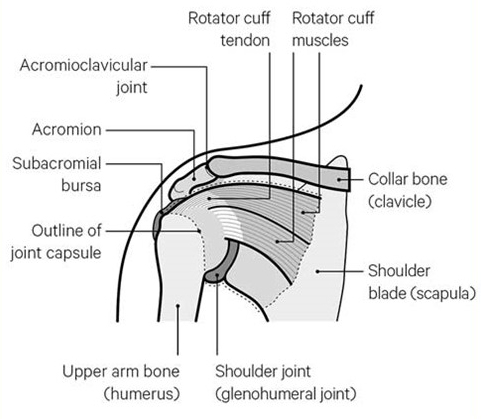Shoulder Pain
How does the shoulder work?
Your shoulders each have two joints, making them the most flexible parts of your body.
The main shoulder joint – the glenohumeral – is a ball-and-socket joint. It’s called this
because the top of the upper arm bone – the humerus – is shaped like a ball. This ball fits into the shoulder blade bone, which acts as the socket, giving your shoulder a wide range of movement.
Above the main shoulder joint there’s a smaller joint where the top of the shoulder blade – the acromion – meets the collar bone.
This is known as the acromioclavicular joint. It helps the larger joint below to move through its full range, particularly when you’re raising your arm, lifting or throwing.

Causes of Shoulder Pain
Shoulder problems are common and can be caused by movements such as lifting something awkwardly, a trip or a fall or doing something repeatedly. As you get older, normal age related changes can cause shoulder pain every now and again, often for no reason. Many respond to simple treatments or self-management.
Shoulder problems can cause a range of symptoms around the shoulder, radiate down the arm as far as the wrist, around the shoulder blade or top of the shoulder, including;
- Pain
- Stiffness
- Weakness
Often you don’t need to see a healthcare professional. New onset or flare-up of a longstanding shoulder problem should settle within 6 weeks.
If you have fallen
If you have fallen and injured your arm or shoulder you should urgently call 111 who will triage if you need urgent care, as there is a small possibility of a bone, tendon or ligament injury to the shoulder.
Self help
Keeping active is an essential part of your treatment and recovery and is the single best thing you can do for your health.
- Prevent a recurrence of the problem
- Maintain your current levels of fitness – even if you have to modify what you normally do, any activity is better than none
- Keep your other muscles and joints strong and flexible
- Keep a healthy body weight
It’s recommended you stay at or return to work as quickly as possible during your recovery.
You don’t need to be pain and symptom free to return to work.
- Rest your shoulder, but avoid long spells of not moving at all
- Move your shoulder gently for 10 to 20 seconds every hour when you are awake
- If you have muscle or ligament injury this video from “The Running Clinic” can help support you in managing your recovery.
- Slowly return to normal activity
- Do whatever you normally would and stay at, or return to work – this is important and is the best way to get better
- Avoid sports or heavy lifting until you have less discomfort and good movement. Remember to warm up fully before you start sporting activities
If you would like advice about medication or other methods of pain relief to help you to manage your pain better speak to your community pharmacist.
Pain medication can help to reduce pain and help you to move more comfortably, which can aid your recovery. When taking pain medication, it is important to take it regularly.”
Here are some useful videos if you are experiencing some problems with your shoulder:
Please watch this video on how to pace your exercise before starting the exercise videos.
If during the video you are experiencing significant pain please stop the video and seek advice from your GP.

